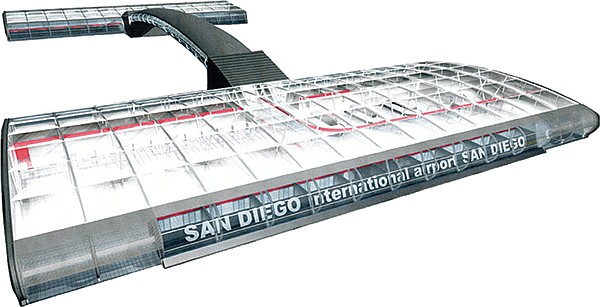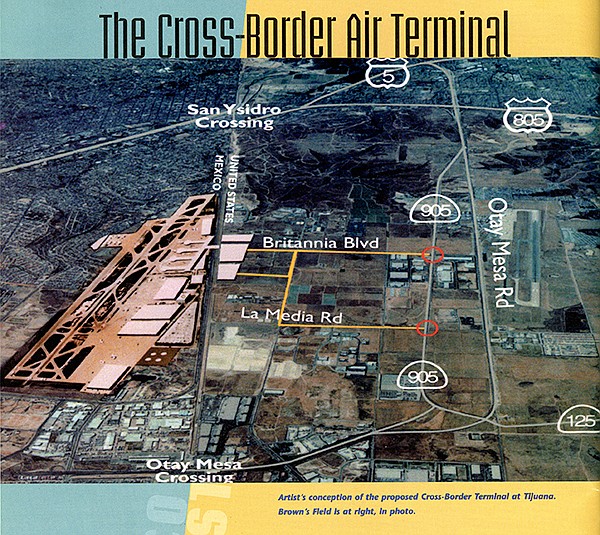 Facebook
Facebook
 X
X
 Instagram
Instagram
 TikTok
TikTok
 Youtube
Youtube

There will be shovels, most likely a ribbon of some sort, and, of course, a group of well-dressed developers and public officials. They will stand at a barren plot of land in Otay Mesa, the hustle and bustle of the Tijuana airport behind them. One person will be missing from the groundbreaking ceremony of the touted Cross Border Terminal, linking San Diego with Tijuana’s A.L. Rodriguez International Airport. Without Ralph Nieders there most likely would never be such a groundbreaking event, or a cross-border terminal, for that matter. Nieders has spent more than 26 years lobbying government officials, drafting plans, and negotiating with landowners to link the two cities. Nieders won’t miss the ceremony because of some illness or due to a prior obligation — he is not invited. Nieders says Chicago billionaire Sam Zell, owner of the Otay Tijuana Venture, has cast him aside without any notice or explanation. Meanwhile, those at the South County Economic Development Council take full credit for Nieder’s work.

“I am the creator and intellectual author of the cross-border terminal, that goes for the configuration and the location. I am the person who re-floated it after it was dead a half dozen times. I spent countless hours briefing officials from San Diego Association of Governments to the San Diego Chamber, the South County Eastern Development Corporation, to dozens of Mexican and U.S. officials, yet I will be the only person who will not get any recognition or be invited to the groundbreaking ceremony,” Nieders says from inside his Chula Vista home as he sits in front of several boxes of paperwork he’s amassed on the proposal.
“The person who started and kept it alive and did the actual work will receive zero credit. A lot of people will make a lot of money at my cost.”
Nieders, who grew up in Tijuana after his family relocated from Sweden, began his work on the cross-border terminal in 1990. Even then he believed the terminal could not only solve the space limitations at Lindbergh Field but could also transform San Diego and Tijuana into a transportation hub by bringing visitors and tons of air cargo to the region, which in turn would boost shipping and other industries in San Diego and Baja.

Nieders moved quickly to get politicians and other officials onboard. In 1990, while working for a contractor at the Tijuana airport, he met with the president of the Mexican chamber of commerce to discuss building a cross-border terminal. The following year, he visited then–San Diego City Council member Ron Roberts, mayors Maureen O’Connor Susan Golding, and former deputy mayor Bob Filner. “I am intrigued by your proposal and interested in pursuing it further…. I appreciate your interest in solving San Diego’s and Tijuana’s airport needs,” Filner wrote in January 1991.
Despite support from officials on both sides of the border, progress stalled for the better part of a decade and relations between the U.S. and Mexico cooled. But Nieders pressed on. He continued to pitch the idea to local officials and managed to make some progress.
In a 2000 city resolution, San Diego city councilmembers named the cross-border terminal a viable option to replace Lindbergh Field.
“Be it further resolved, that the City of San Diego encourages the Mexican authorities to work closely with the City of San Diego towards the goal of developing a Cross Border Air Terminal.”

Then came Nieders’s big break, or so he thought. In February 2002, he flew to Washington DC to meet with Ernesto Velasco, then director of Mexico’s federal airport operator, Aeropuertos y Servicios Auxiliares, and representatives from the State and Treasury departments to discuss the proposal.
“Our departments are working together to synthesize your suggestions into a policy report that shall be presented to [presidents George W. Bush and Vicente Fox] with much fanfare,” Kenneth Dam, then deputy secretary of the Treasury Department to Nieders after the meeting. “We are confident that the presidents will be as excited as we are at the quality of your proposals and the opportunities for Mexicans and Americans alike.”
The support from federal and local officials, however, couldn’t prevent property values from soaring in the years leading up to the great recession, even in what was then desolate former farmland in Otay Mesa, the selected location for the terminal.
Progress once again slowed, and for a time the cross-border terminal was deemed dead. Again, Nieders remained optimistic. After several failed attempts to find investors willing to purchase the land for the terminal, in 2006 Chicago billionaire Sam Zell volunteered to buy it.
Nieders visited former mayor Jerry Sanders’s deputy chief operating officer, James Waring, to inform him of the news. He also briefed the San Diego County Regional Airport Authority.
All the while, Nieders was told that an employment contract from Zell was in the mail.
The contract never showed up.
Now, over seven years later, Nieders’s dream is becoming a reality and representatives from the South County Economic Development Corporation and others assume credit for all of the work.
According to a statement from the South County Economic Development Corporation, chief executive officer Cindy Gompper-Graves was hired in 2003, after much of this had already occurred.
A spokesman for the South County Economic Development Corporation says the organization “hasn’t recognized anyone in particular, but is celebrating the progress as a region. There have been so many people involved along the way that it would hard to single anyone out.”
Nieders disagrees. “The South County Economic Development Corporation had nothing to do with the long process of acquiring the land, or with the 26 years of work was involved to make this happen. My life’s work was to create the world’s first true cross-border terminal and it was stolen because I trusted the wrong people. A lot of people were involved, Mexicans and Americans, and their work will never be known.”
Representatives from Zell’s company, Equity Group Investments, declined to comment.


There will be shovels, most likely a ribbon of some sort, and, of course, a group of well-dressed developers and public officials. They will stand at a barren plot of land in Otay Mesa, the hustle and bustle of the Tijuana airport behind them. One person will be missing from the groundbreaking ceremony of the touted Cross Border Terminal, linking San Diego with Tijuana’s A.L. Rodriguez International Airport. Without Ralph Nieders there most likely would never be such a groundbreaking event, or a cross-border terminal, for that matter. Nieders has spent more than 26 years lobbying government officials, drafting plans, and negotiating with landowners to link the two cities. Nieders won’t miss the ceremony because of some illness or due to a prior obligation — he is not invited. Nieders says Chicago billionaire Sam Zell, owner of the Otay Tijuana Venture, has cast him aside without any notice or explanation. Meanwhile, those at the South County Economic Development Council take full credit for Nieder’s work.

“I am the creator and intellectual author of the cross-border terminal, that goes for the configuration and the location. I am the person who re-floated it after it was dead a half dozen times. I spent countless hours briefing officials from San Diego Association of Governments to the San Diego Chamber, the South County Eastern Development Corporation, to dozens of Mexican and U.S. officials, yet I will be the only person who will not get any recognition or be invited to the groundbreaking ceremony,” Nieders says from inside his Chula Vista home as he sits in front of several boxes of paperwork he’s amassed on the proposal.
“The person who started and kept it alive and did the actual work will receive zero credit. A lot of people will make a lot of money at my cost.”
Nieders, who grew up in Tijuana after his family relocated from Sweden, began his work on the cross-border terminal in 1990. Even then he believed the terminal could not only solve the space limitations at Lindbergh Field but could also transform San Diego and Tijuana into a transportation hub by bringing visitors and tons of air cargo to the region, which in turn would boost shipping and other industries in San Diego and Baja.

Nieders moved quickly to get politicians and other officials onboard. In 1990, while working for a contractor at the Tijuana airport, he met with the president of the Mexican chamber of commerce to discuss building a cross-border terminal. The following year, he visited then–San Diego City Council member Ron Roberts, mayors Maureen O’Connor Susan Golding, and former deputy mayor Bob Filner. “I am intrigued by your proposal and interested in pursuing it further…. I appreciate your interest in solving San Diego’s and Tijuana’s airport needs,” Filner wrote in January 1991.
Despite support from officials on both sides of the border, progress stalled for the better part of a decade and relations between the U.S. and Mexico cooled. But Nieders pressed on. He continued to pitch the idea to local officials and managed to make some progress.
In a 2000 city resolution, San Diego city councilmembers named the cross-border terminal a viable option to replace Lindbergh Field.
“Be it further resolved, that the City of San Diego encourages the Mexican authorities to work closely with the City of San Diego towards the goal of developing a Cross Border Air Terminal.”

Then came Nieders’s big break, or so he thought. In February 2002, he flew to Washington DC to meet with Ernesto Velasco, then director of Mexico’s federal airport operator, Aeropuertos y Servicios Auxiliares, and representatives from the State and Treasury departments to discuss the proposal.
“Our departments are working together to synthesize your suggestions into a policy report that shall be presented to [presidents George W. Bush and Vicente Fox] with much fanfare,” Kenneth Dam, then deputy secretary of the Treasury Department to Nieders after the meeting. “We are confident that the presidents will be as excited as we are at the quality of your proposals and the opportunities for Mexicans and Americans alike.”
The support from federal and local officials, however, couldn’t prevent property values from soaring in the years leading up to the great recession, even in what was then desolate former farmland in Otay Mesa, the selected location for the terminal.
Progress once again slowed, and for a time the cross-border terminal was deemed dead. Again, Nieders remained optimistic. After several failed attempts to find investors willing to purchase the land for the terminal, in 2006 Chicago billionaire Sam Zell volunteered to buy it.
Nieders visited former mayor Jerry Sanders’s deputy chief operating officer, James Waring, to inform him of the news. He also briefed the San Diego County Regional Airport Authority.
All the while, Nieders was told that an employment contract from Zell was in the mail.
The contract never showed up.
Now, over seven years later, Nieders’s dream is becoming a reality and representatives from the South County Economic Development Corporation and others assume credit for all of the work.
According to a statement from the South County Economic Development Corporation, chief executive officer Cindy Gompper-Graves was hired in 2003, after much of this had already occurred.
A spokesman for the South County Economic Development Corporation says the organization “hasn’t recognized anyone in particular, but is celebrating the progress as a region. There have been so many people involved along the way that it would hard to single anyone out.”
Nieders disagrees. “The South County Economic Development Corporation had nothing to do with the long process of acquiring the land, or with the 26 years of work was involved to make this happen. My life’s work was to create the world’s first true cross-border terminal and it was stolen because I trusted the wrong people. A lot of people were involved, Mexicans and Americans, and their work will never be known.”
Representatives from Zell’s company, Equity Group Investments, declined to comment.
Comments